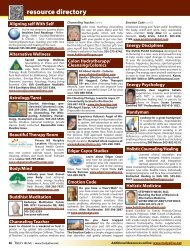reading - Truly Alive Magazine
reading - Truly Alive Magazine
reading - Truly Alive Magazine
You also want an ePaper? Increase the reach of your titles
YUMPU automatically turns print PDFs into web optimized ePapers that Google loves.
Healing Your Brain of Toxins:<br />
What You Need to Know About the Secret<br />
Life of Mercury in Your Brain<br />
By Pamela Costello, MD, PhD, Holistic Neurological Surgeon, Neuroscientist<br />
Symptoms, then, are in reality nothing but the cry from suffering organs.<br />
Neurologist, Jean-Martin Charcot (1825-1893)<br />
The term “mad as a hatter” will forever be<br />
associated with the ‘lunatic’ hat maker in the<br />
classic Alice in Wonderland. Mercury was<br />
commonly used during the process of turning<br />
fur into felt, causing the workers to<br />
breathe in the fumes of this highly<br />
toxic metal. The resultant accumulated<br />
mercury in their bodies led to such<br />
symptoms as tremors (known as<br />
“hatters’ shakes”), loss of coordination,<br />
slurred speech, loosening of teeth,<br />
memory loss, depression or mania,<br />
irritability, and anxiety. Other<br />
mercury related neurodegenerative<br />
and neuroinflammatory diseases,<br />
such as Alzheimer’s and Parkinson’s<br />
Dementias, MS and ALS, brain fog,<br />
restless leg syndrome, neuropathy, as<br />
well as neuropsychiatric disorders,<br />
the Autism Spectrum, and childhood behavioral and<br />
attentional disorders, have all contributed to extensive<br />
human suffering.<br />
The list of neurotoxins to which the human nervous<br />
system is currently being exposed is ever increasing, but<br />
the singular most potent toxic burden (that is largely<br />
avoidable and, in many cases correctable), is the toxin<br />
mercury. It is the single deadliest non-radioactive source<br />
of poison on our planet,<br />
and it’s surprisingly often<br />
overlooked. Although<br />
modern scientific research<br />
is catching up to mercury’s<br />
contribution to neurodegenerative<br />
disease, it’s still<br />
far behind lead toxicity<br />
awareness, and continues<br />
to actively be used in industry<br />
and placed in our<br />
mouths. The truth is that if<br />
you suffer from neurologic<br />
or immunologic illness,<br />
mercury is often a root<br />
cause and knowledge of both your diagnostic and treatment<br />
status is a powerful tool in your recovery.<br />
Knowing the secret life of mercury and other<br />
neurotoxins in your brain just might save your brain<br />
health, your sanity, and possibly even<br />
your life. Mercury in any form is<br />
poisonous, with its greatest toxicity<br />
affecting the nervous and immune<br />
systems, as well as the gastrointestinal<br />
tract and kidneys. The biggest challenge<br />
with diagnosing heavy metal toxicity is<br />
its slow, smoldering effect that eludes<br />
one to the fact that mercury is the root<br />
of their problem.<br />
Wilson’s classic textbook of neurology,<br />
published in 1940, described mercury-induced<br />
cognitive impairments,<br />
such as inattention, excitement, hallucinations,<br />
tremors, sensory loss, visual loss, extremity<br />
numbness, hearing loss, and ataxia. Babies exposed to the<br />
methylmercury in utero were the most severely affected.<br />
Furthermore, because mercury was also discovered in the<br />
breast milk of the mothers, the babies’ exposure continued<br />
after birth. Exposure to mercury begins in the womb,<br />
where the mother transfers the mercury to the developing<br />
fetus across the placenta. After birth, the child’s environmental<br />
exposures continue, with the accumulating,<br />
retained mercury levels continuing to rise. Poisoning<br />
continues throughout development and afterward, with<br />
ongoing exposure resulting from mercury vapor inhalation,<br />
ingestion, injection, and absorption through the<br />
skin from both environmental sources and from mercury<br />
amalgams. Mercury exposure is both treatable and preventable,<br />
with the most preventable and highest risk exposure<br />
to mercury being from dental fillings.<br />
More recent research of Alzheimer’s Disease,<br />
Parkinson’s Disease, ALS and MS reveals a multitude<br />
of neurotoxic effects of mercury on the brain. Mercury<br />
contributes to nerve cell damage by a variety of<br />
mechanisms, both in its inorganic form, as well as the<br />
far more neurotoxic, organic methylmercury form,<br />
14 <strong>Truly</strong> <strong>Alive</strong> | www.trulyalive.net














